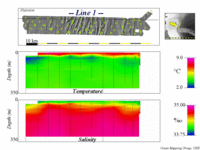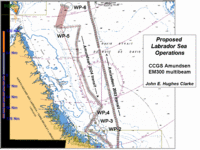
|
Whilst the main aim of the CCGS
Amundsen program in 2005 is ArcticNet science in the high Canadian
Arctic, the vessel has to perform two transits through the Labrador
Sea. As an extension of the transits, a 3 day NSERC-funded mapping
project is being carried out on the upper continental slope off the
mouth of Hudson Strait.
As part of that project, there was a requirement for precise sound
speed field to support
multibeam operations, As a result, ~ 60 MVP casts were performed
on August 10th and
11th (JD's 222 and 223). This page presents preliminary oceanographic
results from those casts.
|
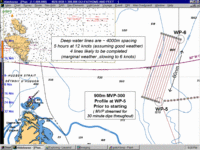 |
The mapping project will
ultimately consist of about 12 contour-parallel lines. These lines are
approximately 110km long and will extend from the 2000m contour,
westward about 35 km to the shelfbreak. To date (on Leg 1), 5 lines
have been completed.
To ensure precise beam steering and refraction modelling, a complete
knowledge of the temporal and spatial variability in sound speed is
required. The deeper (> 500m) watermasses in the area are reasonably
predictable on a seasonable basis.
Thus the requirement was primarily for the shallower structure.
Therefore the MVP-300 was deployed at 12 knots and used for 30 minute
(~10km spacing) dips to 300m.
|
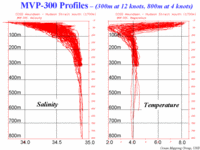 |
The MVP performance was
generally excellent, right up to the point when we lost it. The
adjacent figures illustrates the typical structure and variability. At
the end of each survey line a deeper (500-800m) dip was performed at 4
knots to ascertain whether there was any significant variability in the
deeper water mass.
All profiles were extended to full ocean depths using the World Ocean
Atlas database, interpolated locally.
|
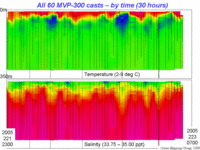 |
The adjacent figure illustrates
a purely time-sequential interpolation of the ~ 60 profiles. As one can
see there is most variability in the temperature minimum at ~50m. Also
the main thermocline above that fluctuates over 40m. Strongly
correlated with, but not identical too, are similar variations in
salinity.
Below we present the data geographically line by line progressing from
the easternmost section to the west.
|
